Video Conferencing Hardware Market Size
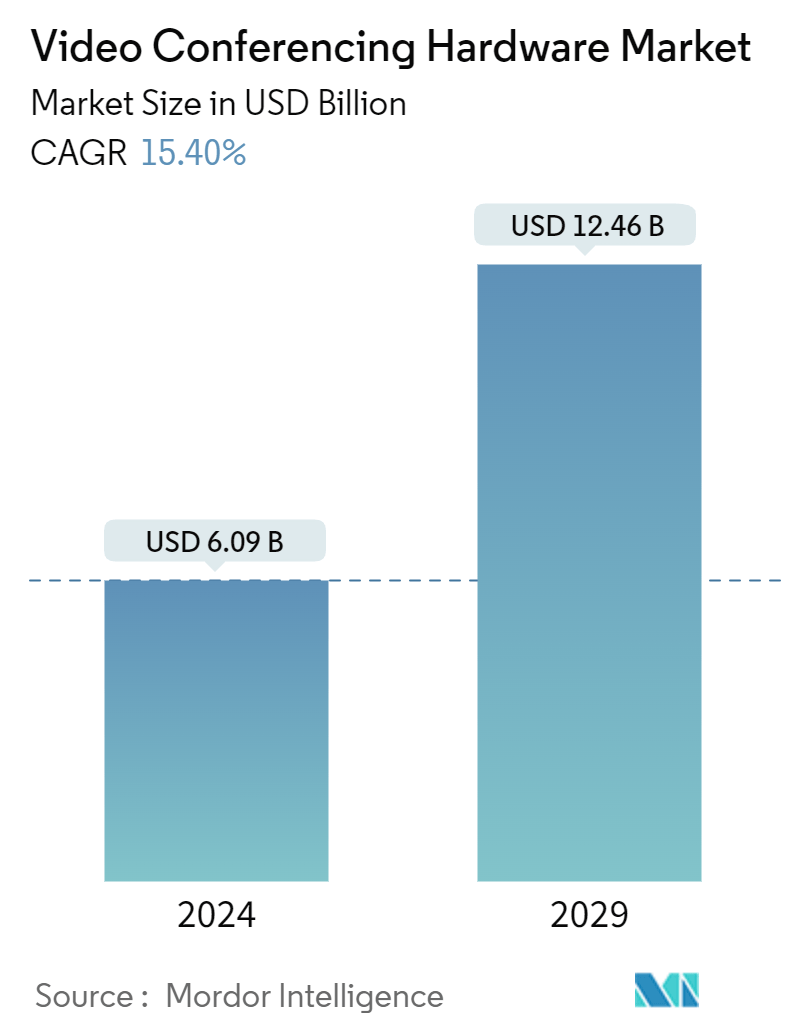
| Study Period | 2019 - 2029 |
| Market Size (2024) | USD 6.09 Billion |
| Market Size (2029) | USD 12.46 Billion |
| CAGR (2024 - 2029) | 15.40 % |
| Fastest Growing Market | Asia Pacific |
| Largest Market | North America |
Major Players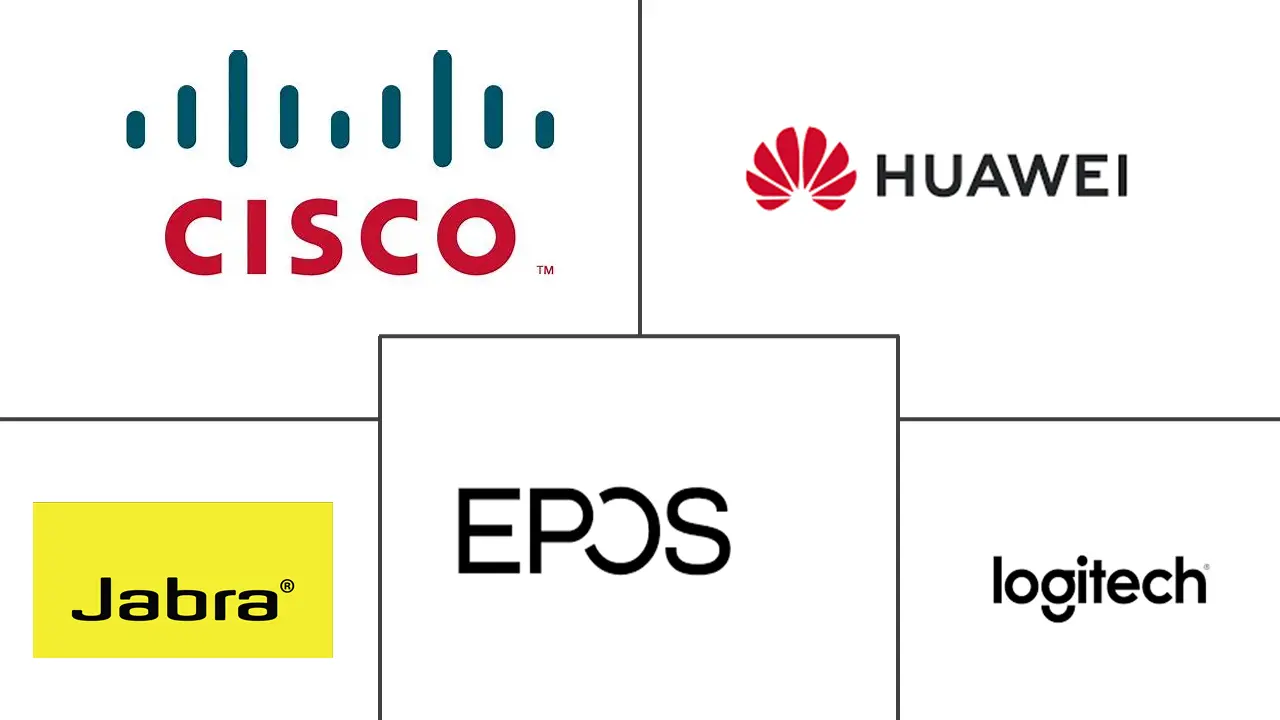
*Disclaimer: Major Players sorted in no particular order |
Video Conferencing Hardware Market Analysis
The Video Conferencing Hardware Market size is estimated at USD 6.09 billion in 2024, and is expected to reach USD 12.46 billion by 2029, growing at a CAGR of 15.40% during the forecast period (2024-2029).
- Video conferencing has become an essential tool in modern communication, connecting individuals and businesses worldwide. Its importance extends beyond everyday meetings and impacts sectors such as institutional and commercial spaces.
- As remote work plans become increasingly accepted due to factors such as globalization and mechanical capacity, interest in video conferencing hardware is growing. Organizations of various businesses conduct virtual meetings, collaborative work, and correspondence through video conferencing.
- Moreover, hybrid work models that combine remote and in-person work are becoming increasingly popular as the workforce embraces flexibility and autonomy. This trend requires a video conferencing solution that seamlessly connects remote and on-site employees to enable productive collaboration regardless of physical location. As organizations transition to hybrid work environments, there is a high demand for video conferencing hardware that offers features including virtual meeting rooms, screen sharing, and mobile accessibility, thus driving the demand for the video conferencing hardware market.
- With the proliferation of high-speed internet and the wide spread of laptops, tablets, and smartphones, video conferencing has become an indispensable communication solution for enterprises, offices, and individuals globally. Furthermore, according to the National Bureau of Statistics of China, during January/February of 2024, the production value of finished computers in China stood at 45.45 million units.
- Limited communication infrastructure in emerging and underdeveloped nations hinders high-quality video transmission. Thus, the lack of a strong communication infrastructure represents a significant challenge for the video conferencing hardware market.
- Macroeconomic factors such as government regulation on the import/export of video conferencing hardware products can significantly impact the market's growth. These regulations vary from country to country, often requiring extensive certifications, testing, and adherence to specific standards. While these regulations aim to ensure safety and quality, they can pose significant challenges for manufacturers, distributors, and end-users.
Video Conferencing Hardware Market Trends
Commercial Space Segment Expected to Hold Significant Share
- The wide adoption of video conferencing hardware in the commercial space is driven by the need for effective communication and collaboration tools, especially as the trend toward remote and hybrid working models increases.
- Businesses use video conferencing to enable virtual meetings, project collaboration, and real-time communication between geographically distributed teams. The need for secure and seamless communication solutions, combined with the need to improve productivity and decision-making processes, has put the business at the forefront of video conferencing implementation.
- The demand for video conferencing in the office is increasing as it helps to boost productivity. Instead of sending an email to a colleague or employee and expecting an answer the next day, employees can connect for a fast video conference session and use a screen-share tool to go on with their project.
- Moreover, the mobility and flexibility of video conferencing give employees more control over their work time, which increases loyalty. When remote workers can interact face-to-face with colleagues on a regular basis, they feel more connected and part of a team. Thus, such benefits increase the adoption of video conferencing in commercial spaces and drive the market's growth during the projected timeline.
- Furthermore, several vendors in the market are focusing on offering new products for video conferencing to improve the user experience. For instance, in January 2024, Thundercomm announced introducing its new set of AI video conferencing solutions at CES 2024. The launch aims to improve the experience and efficiency of business communication and collaboration. It is based on the all-in-one video bar based on the Qualcomm Video Collaboration VC5 platform and comes with a four-camera implementation. This solution allows users to enjoy a premium and engaging video conferencing experience.
- Moreover, the rising construction and expansion of office space are also expected to support the market's growth. According to the Australian Bureau of Statistics, in 2023, the value of construction work done on offices in Australia came to approximately AUD 10 billion (USD 6.60 Billion) compared to AUD 8.7 billion (USD 5.74 billion) in 2022.
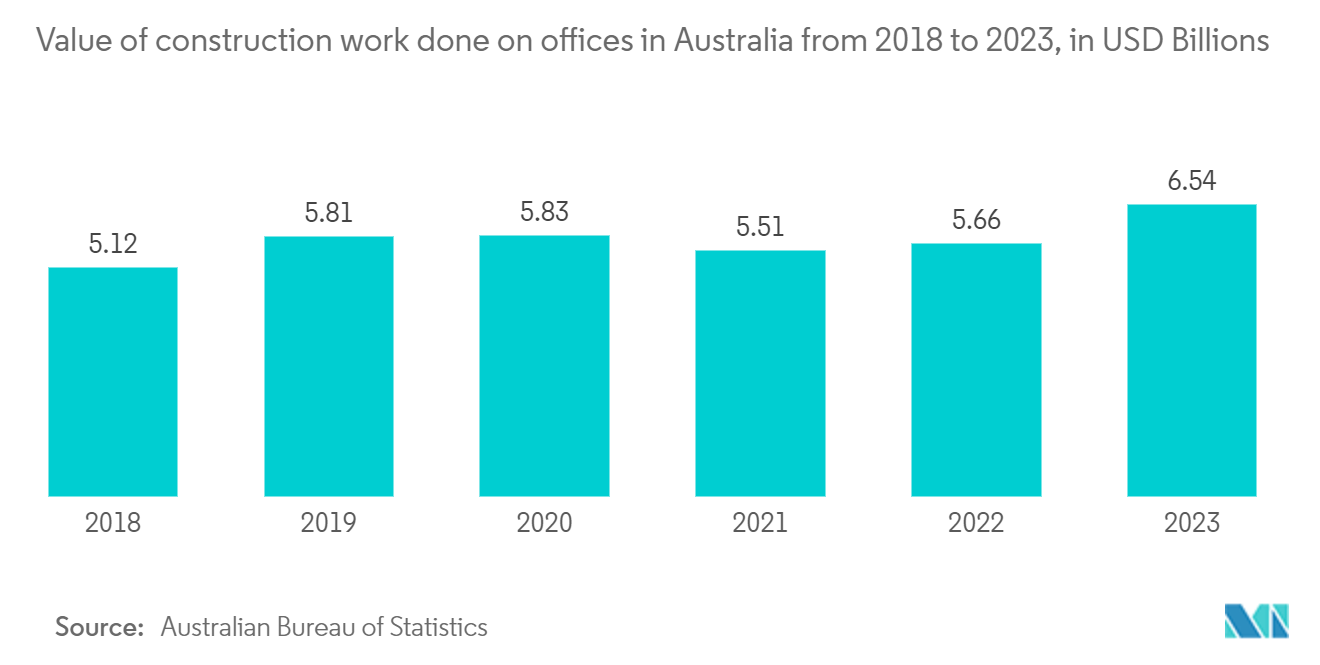
North America is Expected to Hold Major Share
- The demand for video conferencing hardware in North America is increasing as the United States and Canada have well-established internet infrastructure, including numerous telecommunications companies and hardware providers. The development of 5G networks with faster speeds and higher image and video quality is expected to transform the video conferencing industry.
- The widespread adoption of remote work and the need for seamless virtual communication has increased the demand for video conferencing hardware in North America. Additionally, the continued shift in culture toward flexible working arrangements and the demand for efficient and cost-effective communication platforms have accelerated the market's growth. As businesses aim to improve productivity and streamline communication processes, the video conferencing market continues to evolve, providing ample opportunity for innovation and market expansion for remote collaboration solutions.
- According to a survey by Tech.co, in 2023, 90% of respondents working for companies in the United States and able to work fully remotely reported that their organization was using video conferencing, while only 70% of respondents expected to be in the office at least five days a week mentioned using this tool.
- Many multinational companies in the region, such as IBM Corporation, are focusing on the widespread use of these hardware for employee training, which will have a beneficial impact on the market's growth. For example, IBM Corporation uses Cisco Systems video conferencing systems to provide integrated training to employees working in various locations worldwide.
- Several video conferencing hardware providers in the region are offering diverse and sophisticated products to meet the growing demand for improved technology in video conferencing hardware, thereby boosting the market. For instance, in March 2024, FS announced the launch of the FS FC570S 4K all-in-one conference camera, carefully designed to enhance the video conferencing experience for all participants. The device is built with an ultra-high-definition 4K sensor and boasts a 121 ultra-wide-angle lens that covers the entire room. With an impressive array of four microphones and cutting-edge noise reduction and echo cancellation, the FC570S 4K delivers pristine audio clarity for an immersive meeting experience.
- Furthermore, in April 2024, Mobile Video Devices Inc. (MVD) announced a new distribution partnership with Telycam. MVD will distribute and support Telycam's PTZ cameras and webcams, including the flagship Explore series for live broadcast production, to system integrators and resellers in the United States and Canada, with exclusive US distribution rights.
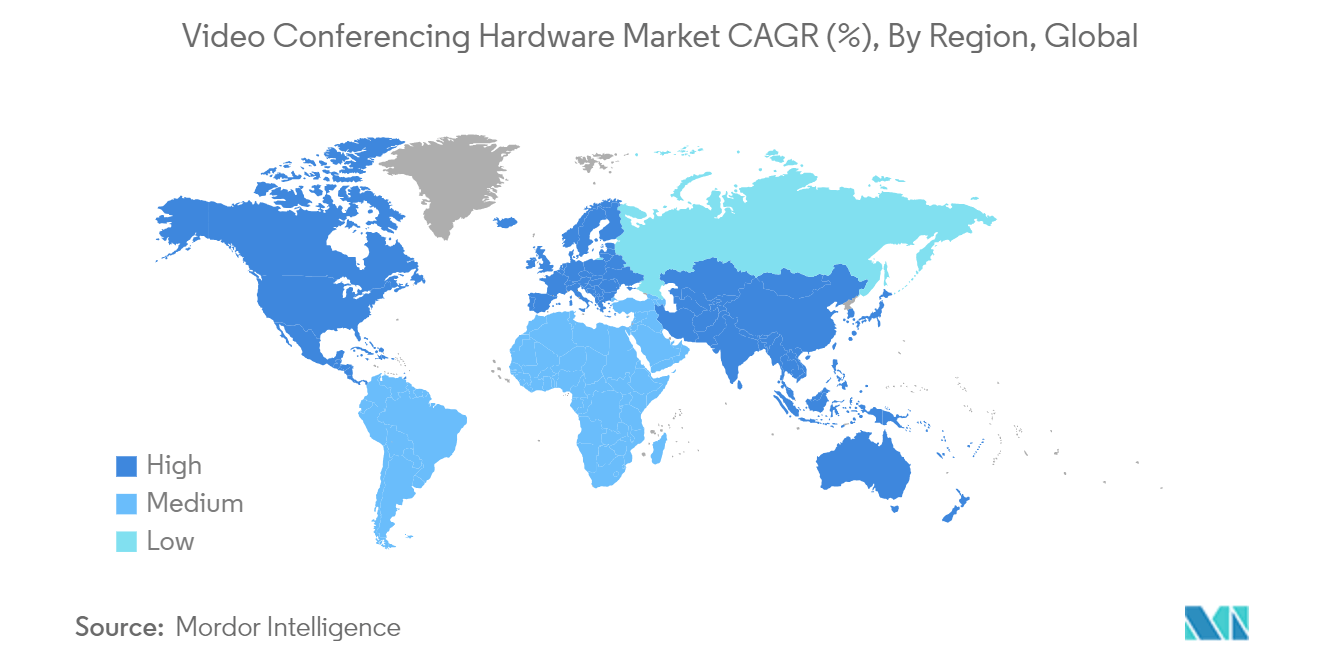
Video Conferencing Hardware Industry Overview
The video conferencing hardware market is consolidated as global players innovate their products to provide cost-benefit offers to users, which creates high rivalry among market competitors. Major players with a prominent share in the market are focusing on expanding their customer base across foreign countries by leveraging strategic collaborative initiatives to increase their market share and profitability. Key players are Cisco System Inc., Logitech International SA, Jabra, EPOS, Huawei Technologies Co. Ltd, etc.
- March 2024: Cisco announced the launch of a new multifunction device purpose-built to deliver a modernized collaboration experience for today's hybrid workforce. Cisco Board Pro G2 is an AI-powered, touch-enabled collaboration device. The Cisco Desk Phone 9800 Series is designed to deliver a modern, personalized productivity hub to every desk.
- January 2024: Barco announced the launch of ClickShare Bar, an innovative video bar that enables wireless conferencing in medium-sized and small meeting rooms. This video bar enhances the renowned ClickShare experience with high quality audio and video features intelligently integrated into one powerful device. ClickShare Bar is easy to install, has a low total cost of ownership, and offers unparalleled flexibility.
Video Conferencing Hardware Market Leaders
-
Cisco System, Inc.
-
Logitech International S.A
-
Jabra
-
Huawei Technologies Co., Ltd.
-
EPOS
*Disclaimer: Major Players sorted in no particular order
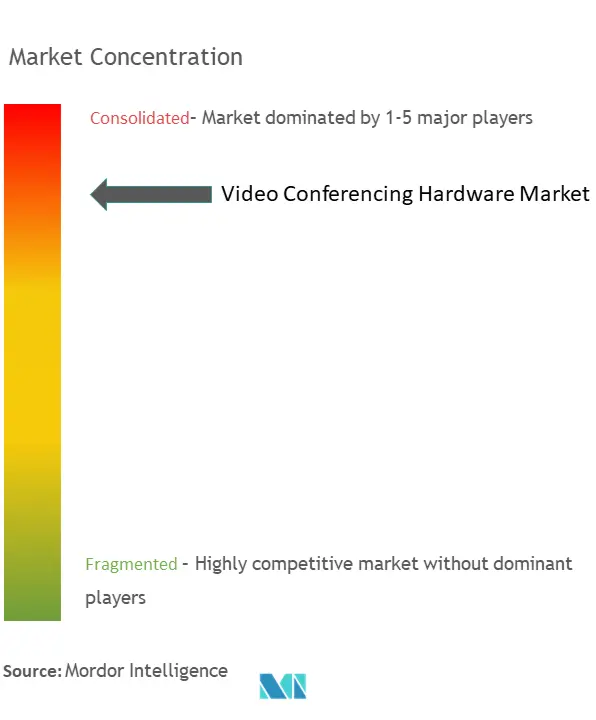
Video Conferencing Hardware Market News
- January 2024: DTEN announced that it is expanding its product line with the launch of the new DTEN Bar and DTEN Mate, a complete video conferencing solution designed specifically for use in small meeting spaces and across any display. Advanced AI-based audiovisual capabilities, simplicity to deploy, use, and manage, and a central camera that can be mounted horizontally or vertically provide the flexibility to meet the needs of a variety of meeting room configurations.
- October 2023: Cisco announced the launch of the new Webex AI Assistant with new features that will enhance customer productivity and accuracy. The Webex AI Strategy and Webex AI Assistants apply to the entire Webex portfolio, including Webex Family, Cisco Collaboration Devices, Webex Contact Center, Webex Connect, and Webex Control Hub.
Video Conferencing Hardware Market Report - Table of Contents
1. INTRODUCTION
- 1.1 Study Assumptions and Market Definition
- 1.2 Scope of the Study
2. RESEARCH METHODOLOGY
3. EXECUTIVE SUMMARY
4. MARKET INSIGHTS
- 4.1 Market Overview
-
4.2 Industry Attractiveness - Porter's Five Forces Analysis
- 4.2.1 Threat of New Entrants
- 4.2.2 Bargaining Power of Buyers/Consumers
- 4.2.3 Bargaining Power of Suppliers
- 4.2.4 Threat of Substitute Products
- 4.2.5 Intensity of Competitive Rivalry
- 4.3 Industry Value Chain
- 4.4 Impact of COVID-19 Aftereffects and Other Macroeconomic Factors on the Market
5. MARKET DYNAMICS
-
5.1 Market Drivers
- 5.1.1 Rising Trend for Remote Works
- 5.1.2 Rapid Migration to Cloud Video Conferencing
-
5.2 Market Restraints
- 5.2.1 High Cost of Hardware Solutions Deployment
6. MARKET SEGMENTATION
-
6.1 By Type of Hardware
- 6.1.1 Multi Control Units (MCU)
- 6.1.2 Collaboration Bars
- 6.1.3 Codec Systems
- 6.1.4 USB Cameras
- 6.1.5 USB-based Interagted Bars
- 6.1.6 Other Bundled Kits
- 6.1.7 Enterprise Headsets
-
6.2 By End User
- 6.2.1 Institutions
- 6.2.2 Commercial Spaces
-
6.3 By Geography***
- 6.3.1 North America
- 6.3.1.1 United States
- 6.3.1.2 Canada
- 6.3.2 Europe
- 6.3.2.1 United Kingdom
- 6.3.2.2 Germany
- 6.3.2.3 France
- 6.3.2.4 Italy
- 6.3.3 Asia
- 6.3.3.1 China
- 6.3.3.2 Japan
- 6.3.3.3 India
- 6.3.3.4 South Korea
- 6.3.4 Australia and New Zealand
- 6.3.5 Latin America
- 6.3.5.1 Brazil
- 6.3.5.2 Argentina
- 6.3.5.3 Mexico
- 6.3.6 Middle East and Africa
- 6.3.6.1 South Africa
- 6.3.6.2 United Arab Emirates
- 6.3.6.3 Saudi Arabia
7. COMPETITIVE LANDSCAPE
-
7.1 Company Profiles*
- 7.1.1 Cisco Systems Inc.
- 7.1.2 Logitech International SA
- 7.1.3 Jabra
- 7.1.4 Huawei Technologies Co. Ltd
- 7.1.5 EPOS
- 7.1.6 Poly
- 7.1.7 Barco
- 7.1.8 TrueConf LLC
- 7.1.9 Nexvoo
- 7.1.10 Aver
8. MARKET OUTLOOK
** Subject To AvailablityVideo Conferencing Hardware Industry Segmentation
The study tracks the revenue accrued through the sale of video conferencing hardware by various players in the global market. The study also tracks the key market parameters, underlying growth influencers, and major vendors operating in the industry, which supports the market estimations and growth rates over the forecast period. The study further analyses the overall impact of COVID-19 aftereffects and other macroeconomic factors on the market. The report’s scope encompasses market sizing and forecasts for various market segments.
The video conferencing hardware market is segmented by type of hardware (multi-control units, collaboration bars, codec systems, USB cameras, USB-based integrated bars, other bundled kits, and enterprise headsets), by end-user (institutions and commercial spaces), and geography (North America (United States, Canada), Europe (United Kingdom, Germany, France, Italy, and Rest of Europe), Asia-Pacific (China, Japan, India, South Korea, and Rest of Asia-Pacific), Latin America (Brazil, Argentina, Mexico, and Rest of Latin America), and Middle East & Africa (South Africa, United Arab Emirates, Saudi Arabia, and Rest of Middle East & Africa)). The market sizes and forecasts are provided in terms of value (USD) for all the above segments.
| By Type of Hardware | Multi Control Units (MCU) | |
| Collaboration Bars | ||
| Codec Systems | ||
| USB Cameras | ||
| USB-based Interagted Bars | ||
| Other Bundled Kits | ||
| Enterprise Headsets | ||
| By End User | Institutions | |
| Commercial Spaces | ||
| By Geography*** | North America | United States |
| Canada | ||
| By Geography*** | Europe | United Kingdom |
| Germany | ||
| France | ||
| Italy | ||
| By Geography*** | Asia | China |
| Japan | ||
| India | ||
| South Korea | ||
| By Geography*** | Australia and New Zealand | |
| Latin America | Brazil | |
| Argentina | ||
| Mexico | ||
| Middle East and Africa | South Africa | |
| United Arab Emirates | ||
| Saudi Arabia |
Video Conferencing Hardware Market Research FAQs
How big is the Video Conferencing Hardware Market?
The Video Conferencing Hardware Market size is expected to reach USD 6.09 billion in 2024 and grow at a CAGR of 15.40% to reach USD 12.46 billion by 2029.
What is the current Video Conferencing Hardware Market size?
In 2024, the Video Conferencing Hardware Market size is expected to reach USD 6.09 billion.
Who are the key players in Video Conferencing Hardware Market?
Cisco System, Inc., Logitech International S.A, Jabra, Huawei Technologies Co., Ltd. and EPOS are the major companies operating in the Video Conferencing Hardware Market.
Which is the fastest growing region in Video Conferencing Hardware Market?
Asia Pacific is estimated to grow at the highest CAGR over the forecast period (2024-2029).
Which region has the biggest share in Video Conferencing Hardware Market?
In 2024, the North America accounts for the largest market share in Video Conferencing Hardware Market.
What years does this Video Conferencing Hardware Market cover, and what was the market size in 2023?
In 2023, the Video Conferencing Hardware Market size was estimated at USD 5.15 billion. The report covers the Video Conferencing Hardware Market historical market size for years: 2019, 2020, 2021, 2022 and 2023. The report also forecasts the Video Conferencing Hardware Market size for years: 2024, 2025, 2026, 2027, 2028 and 2029.
Video Conferencing Hardware Industry Report
Statistics for the 2024 Video Conferencing Hardware market share, size and revenue growth rate, created by Mordor Intelligence™ Industry Reports. Video Conferencing Hardware analysis includes a market forecast outlook for 2024 to 2029 and historical overview. Get a sample of this industry analysis as a free report PDF download.



